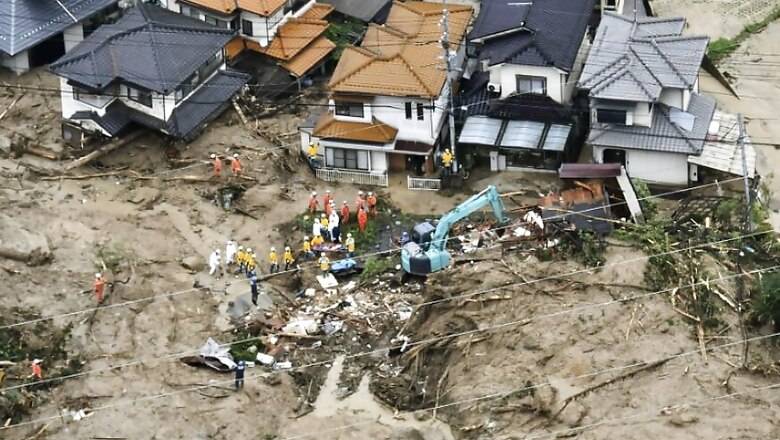
views
Tokyo: Heavy rainfall is hammering southern Japan for the third day, prompting new disaster warnings on Kyushu and Shikoku islands as local media report the death toll has risen to 54 with 44 people missing.
The Japan Meteorological Agency says three hours of rainfall in one area in Kochi prefecture reached an accumulated 26.3 centimeters (10.4 inches), the highest since such records started in 1976.
The assessment of casualties is difficult because of the widespread area affected by the rain, flooding and landslides.
Authorities warn landslides can strike even after rain subsides as the calamity is shaping up to be potentially the worst in decades.
Prime Minister Shinzo Abe warned of a "race against time" to rescue the flood victims.
"Rescues, saving lives and evacuations are a race against time," Abe said as he met with a government crisis cell set up to respond to the disaster. "There are still many people whose safety has yet to be confirmed," he added.
The rain has completely blanketed some villages, forcing desperate residents to take shelter on their rooftops with flood water swirling below as they wait for rescue.
Over two million people have been told to evacuate, but the orders are not mandatory and many remained at home, becoming trapped by rapidly rising water or sudden landslides.
The meteorological agency issued its highest level alert for two new regions on Sunday, while lifting the alerts for other areas where rains were subsiding.
Roads turned into rivers
In the town of Mihara, in the south of the Hiroshima region, a temporary let-up in rain laid bare the devastation wrought by the downpours.
Roads were transformed into muddy flowing rivers, with dirt piled up on either side and stranded cars barely withstanding the current flowing around their wheels.
"The area became an ocean," said 82-year-old Nobue Kakumoto, a long-time resident.
"I'm worried because I have no idea how long it will stay like this."
Work crews could be seen elsewhere trying to clear multiple small landslides that coated roads in mud, rendering them virtually impassable.
"We are carrying out rescue operations around the clock," Yoshihide Fujitani, a disaster management official in Hiroshima prefecture, told AFP.
"We are also looking after evacuees and restoring lifeline infrastructure like water and gas," he added.
"We are doing our best."
In western Okayama prefecture, around 200 people including children and elderly people were trapped in a hospital after a river burst its banks and flooded the surrounding area.
"The electricity and water has been cut off. We are suffering water and food shortages," a nurse told public broadcaster NHK.
Homes washed away
Over 50,000 rescue workers, police and military personnel have been mobilised to respond to the disaster, which has left entire villages submerged by flooding, with just the top of traffic lights visible above the rising waters.
"My house was simply washed away and completely destroyed," Toshihide Takigawa, a 35-year-old employee at a gas station in Hiroshima, told the Nikkei daily on Saturday.
"I was in a car and massive floods of water gushed towards me from the front and back and then engulfed the road. I was just able to escape, but I was terrified," 62-year-old Yuzo Hori told the Mainichi Shimbun daily in Hiroshima.
Though the typhoon began last week, the worst of the rain hit from Thursday, when a construction worker was swept away by floodwaters in western Japan.
The toll has risen steadily since then, and the conditions have made rescue operations difficult, with some desperate citizens taking to Twitter to call for help.
"Water came to the middle of the second floor," a woman in Kurashiki, Okayama wrote, posting a picture of her room half swamped by flooding.
"The kids could not climb up to the rooftop," she said. "My body temperature has lowered. Rescue us quickly. Help us."
In some place rescuers were using boats, or helicopters to airlift those affected to safety.
Several major manufacturers, including carmakers Daihatsu and Mitsubishi, said they had suspended operations at plants in the affected areas.
The disaster is the deadliest rain-related crisis in Japan since 2014, when at least 74 people were killed in landslides caused by torrential downpours in the Hiroshima region.


















Comments
0 comment